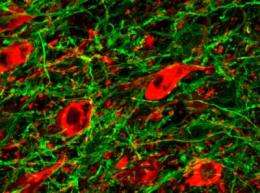Study shines light on brain mechanism that controls reward enjoyment

What characterizes many people with depression, schizophrenia and some other mental illnesses is anhedonia: an inability to gain pleasure from normally pleasurable experiences.
Exactly why this happens is unclear. But new research led by neuroscientists at the University of North Carolina at Chapel Hill School of Medicine may have literally shined a light on the answer, one that could lead to the discovery of new mental health therapies. A report of the study appears March 22 in the journal Neuron.
The study used a combination of genetic engineering and laser technology to manipulate the wiring of a specific population of brain cells deep in a portion of a midbrain area that's known to promote behavioral responses to reward.
"For many years it's been known that dopamine neurons in the ventral midbrain, the ventral tegmental area, or VTA, are involved in reward processing and motivation. For example, they're activated during exposure to drugs of abuse and to naturally rewarding experiences," said study lead author Garret D. Stuber, PhD, assistant professor in the departments of Psychiatry and Cell and Molecular Physiology, and the UNC Neuroscience Center.
"The major focus in our lab is to determine what other sorts of neural circuits or genetically defined neural populations might be modulating the activity of those neurons, whether it's increasing or decreasing their activity," Stuber said. "In our study we found that activation of the nearby VTA GABAergic neurons directly inhibit the function of dopamine neurons, which is something that's never been shown before."
In the past, researchers have tried to get a glimpse into the inner workings of the brain using electrical stimulation or drugs, but those techniques couldn't quickly and specifically change only one type of cell or one type of connection. But optogenetics, a technique that emerged about six years ago, can.
In this study, the scientists used a transgenic animal with a foreign gene that has been inserted into its genome to express a bacterial enzyme that can cause DNA recombination only in GABA neurons and not dopamine cells. Using a gene transfer method developed at UNC and with the animal anesthetized, the Stuber team transferred light-sensitive proteins called "opsins" – derived from algae or bacteria that need light to grow – into the VTA, targeting GABA cells. The presence of these foreign opsins in GABA neurons allows researchers to excite or inhibit them by pumping light from a laser into brain tissue.
The animals were then tested in different reward situations, simple tasks in which they were trained to associate a cue with a sugar water reward from a bottle or were given the opportunity to drink the reward by "free licking," where they could drink as much as they want.
Then, via optical fibers, the researchers shined laser beams onto the genetically manipulated GABA neurons, activating them for 5 seconds during the cue period followed by reward. And on another day, they activated the neurons during reward consumption, when the animals were actively engaged in drinking the sugar water.
"And what we saw when we activated the cells during the cue period, or reward anticipation, it didn't do anything to the behavioral response at all; they showed no difference compared to non-stimulated animals," Stuber explained.
"And when they were actively engaging with the sucrose, we did see we could disrupt their reward consumption when we activated those cells. They immediately disengaged from drinking, stopped drinking the sucrose solution. And when the stimulus stopped, they would then return back and continue to drink it again."
During the "free licking" sessions, optical stimulation of GABA neurons resulted in disruption of sucrose consumption. The animals stopped drinking.
Using sophisticated electrophysiology and cell chemistry measures, the study team could monitor the activity of the GABA and dopamine neurons. They found a direct link between GABA activation and dopamine suppression.
"So basically, it appears that these GABA neurons located in the VTA are just microns away from dopamine and are negative regulators of dopamine function," Stuber proposes.
"When they become active, their basic job is to suppress dopamine release. A dysfunction in these GABA neurons might potentially underlie different aspects of neuropsychiatric illness, such as depression. Thus, we could think of them as a new physiological target for various aspects of neuropsychiatric diseases."

















